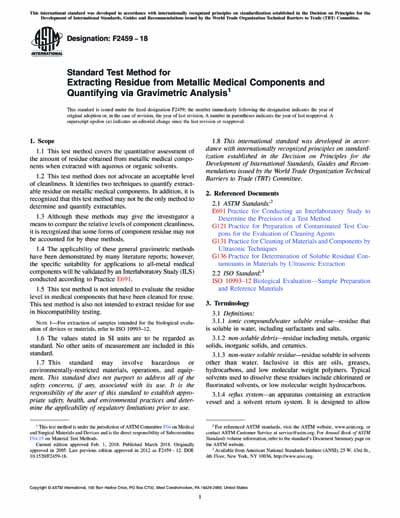Most recent
ASTM F2459-18
Standard Test Method for Extracting Residue from Metallic Medical Components and Quantifying via Gravimetric Analysis
1.1 This test method covers the quantitative assessment of the amount of residue obtained from metallic medical components when extracted with aqueous or organic solvents.
1.2 This test method does not advocate an acceptable level of cleanliness. It identifies two techniques to quantify extractable residue on metallic medical components. In addition, it is recognized that this test method may not be the only method to determine and quantify extractables.
1.3 Although these methods may give the investigator a means to compare the relative levels of component cleanliness, it is recognized that some forms of component residue may not be accounted for by these methods.
1.4 The applicability of these general gravimetric methods have been demonstrated by many literature reports; however, the specific suitability for applications to all-metal medical components will be validated by an Interlaboratory Study (ILS) conducted according to Practice E691.
1.5 This test method is not intended to evaluate the residue level in medical components that have been cleaned for reuse. This test method is also not intended to extract residue for use in biocompatibility testing.
Note 1: For extraction of samples intended for the biological evaluation of devices or materials, refer to ISO 10993–12.
1.6 The values stated in SI units are to be regarded as standard. No other units of measurement are included in this standard.
1.7 This standard may involve hazardous or environmentally-restricted materials, operations, and equipment. This standard does not purport to address all of the safety concerns, if any, associated with its use. It is the responsibility of the user of this standard to establish appropriate safety, health, and environmental practices and determine the applicability of regulatory limitations prior to use.
1.8 This international standard was developed in accordance with internationally recognized principles on standardization established in the Decision on Principles for the Development of International Standards, Guides and Recommendations issued by the World Trade Organization Technical Barriers to Trade (TBT) Committee.
Content Provider
ASTM International [astm]






